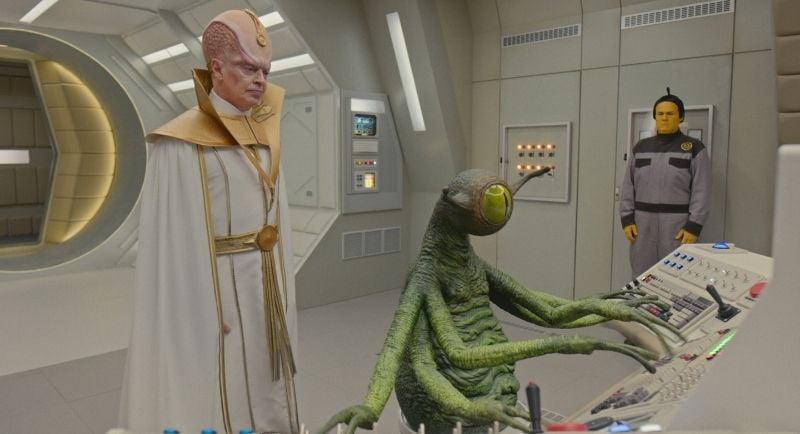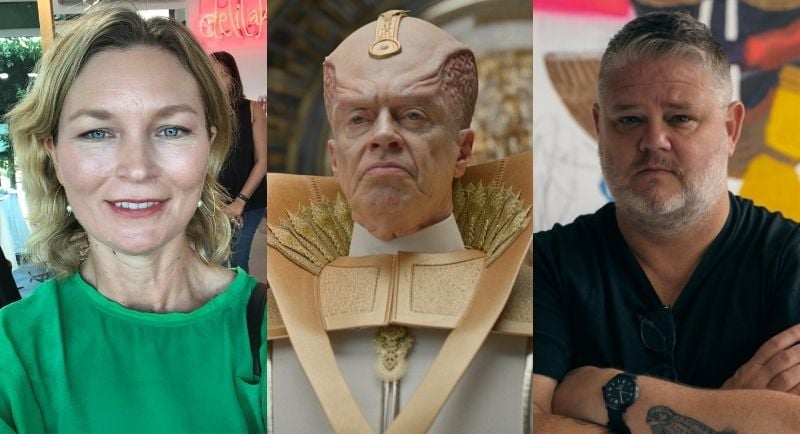Creative risk was not at the centre of objectives for Alita McMenamin, head of brand, network and sponsorship of Telstra, it’s agency village +61 when developing the recently launched Cyber Security campaign, starring Steve Buscemi.
She told Mediaweek that it would be risky if they “did something really vanilla.”
The ad features Buscemi as an intergalactic Emperor attempting to take over Australia with hi-tech scams, but his schemes are foiled as his crew are repeatedly defeated by Telstra’s network.
McMenamin said: “We always start with what the business objectives are or what the business challenges that we’re trying to solve. We all work super collaboratively in trying to get to the best idea to crack that.
“If we just did a security campaign that played into all the tropes of the category, we might get missed. That would be riskier than what we’ve done. We’ve brought in entertainment and humour to tell that story.”
From the business’ perspective McMenamin said that while it is still a bit early in getting the results of the campaign there have been plenty of positive feedback and entertaining.
Micah Walker, BMEOF Chief Creative Officer, told Mediaweek the campaign has attracted international industry attention despite being created for an Australian business and its local customers.
“In the first four days, (the campaign) it was in like 50 different publications. You feel really good when you have customers saying they want to see more of your advertising. That’s always nice.”

Alita McMenamin and Micah Walker
Bringing humour to cybersecurity
Cybersecurity related campaigns have typically tackled with a serious, fear-driven tone but for Walker that was a category trope they wanted to avoid.
The agency village flipped that by drawing attention to the work Telstra is doing behind the scenes to protect its customers.
“There were kind of two tropes, there was either fear or a manifestation of the thing that protects, whether it’s an animal or some large metaphor for what’s protecting you. The last thing we wanted to do was go there.
“From a brand that’s more optimistic about the way things can work in the future and hardworking behind the scenes, we thought it was the right place to bring a little bit more confidence and comedy to it.”
He also noted that the campaign’s unique, optimistic position on the ad leans into position as a leading brand in the category that can be trusted.
“All that we’re doing there is hyperbolically stating a truth that there’s a lot that tells for blocks. Make it memorable. Don’t make it scary. Is there a way that you can find a more kind of leadership position.”

Alita added: “It’s building off what we’ve been trying to do with the brand over the last couple of years about making our brand feel differently so people feel differently about us.”
Buscemi’s part in the campaign captured plenty of attention and Walker explained that the role of the alien invader emperor was intended for someone that was not Australian and had the comedic understanding the character’s ambition.
“There’s a lot of conscious decisions around creating a retro vibe around the villainy and the world. It was part of the idea that they were always one step behind Telstra and Australians that were with Telstra.
“Whenever you’re playing with that calibre of celebrity, you can get your heart broken if you only ever have one choice. We talked to a few folks and Steve happened to be in Europe at the time that our whole production was on in Prague, which was complete coincidence.
“But I think even better, he got the comedy and thought it was funny and therefore thought he could bring something to that character.”
Walker noted that the ad’s director, Randy Krallman, likened the ad to workplace comedy.
“All those little details just make it feel watchable and make the comedy feel a little bit more sophisticated,” Walker added.
Leaning into imagination to deliver cut through
In addition to longer formats in TV and cinema, the campaign also has short-form content of the campaign for social platforms, aimed at extending the story and entertainment those channels and designed to stopping scrolling and grab attention.
“Micah and the team did a great job of just adding more little scenes and moments of our characters and bringing them to life to tell you that security message in an entertaining way.
McMenamin: “I think humour is definitely a part of us and what we’re trying to do with the brand. People love humour. We know it works well, gets a lot of cut through.
“We’re a big corporate brand, but we’re not boring. We’re playful and imaginative, and humour is part of that magic of the brand that we’re trying to bring through more and more in our campaigns.”
For Walker, he noted that often there are campaigns that find the right avenue but repeat the formula.
“Telstra is a brand that does so many things and touches so many different people that for us, we’re trying to find a range of attributes that feel right, always guided by the underlying platform and core idea.”
He noted that while there are parameters for what are considered the ingredients for cohesion or consistency
“There are times where it’s okay to have a bit of fun and have a giggle. Then there’s other times where that’s a little bit wry, and then there are other times where we’re a little bit more leaning on the artful.
“We’re just trying to remain imaginative and find a way to express Telstra and what we’re communicating in an original way.”

Shaping How People Feel About Telstra
Telstra has had a string of successful and interesting ad campaigns over the past 18 months, from the festive Together Is for Christmas, stop-motion Better on a Better Network, whistling Wherever we go ad.
The ads, which have run at different periods for Telstra’s different products in channels for different target audiences, have had very different visual themes and tones.
Walker said the overall body of work is more cohesive. “But that doesn’t mean it’s only ever one voice,” he added.
“What holds it all together, in terms of the way people feel about Telstra, is that being constantly imaginative and surprising can actually become the signature fingerprint of a brand.
“It’s quite conscious to make sure that there is a human hand across everything that we make, that humans are involved in the imagination and creation of the things that we make, whether that be from storytelling to the actual production techniques that make Telstra work distinctive.”
“I think it’s much more cohesive than people think. It is different than the way a lot of brands are conducting their campaigns.
“The scale of Telstra and the breadth of what Telstra does and what it offers that if you just had one systematic technique or framework that you repeated time and time again; it would have a nulling effect across the variety of messages.”
Walker noted that big brands need solutions that are cohesive and have consistencies across all the work in little decisions which have proved to be just as effective.
He noted that for Telstra, the mission at the beginning of the overall brand process was to make people feel differently about Telstra, by changing the way Telstra felt.
“That has guided all of those decisions, not just subjective whims. There’s a plan, and I feel like we’ve stuck to it. What you’ll start to see is we can revisit some of those stories later on. We can come back to them.
McMenamin added: “We don’t want to just be in one style. It’s about how we can keep surprising people and getting attention because we know it’s harder and harder to get that cut through.
“The tonal part is the consistency. We’ve used different techniques for our campaigns, and we’ve got some strong brand codes that we keep reinforcing through everything as well to help get that consistency.”
Top image: Alita McMenamin, Steve Buscemi, Micah Walker
